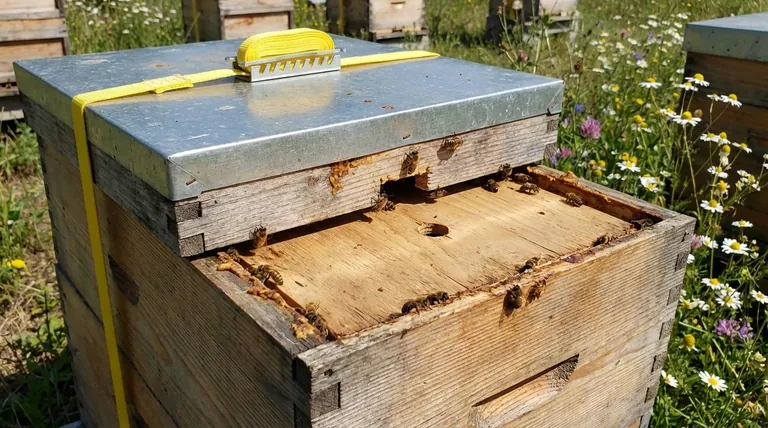At its core, a beehive's cover system is a two-part design with distinct functions. The inner cover serves as a ceiling for the bees, providing crucial insulation and preventing them from sealing the hive shut. The outer cover acts as the roof, offering the primary defense against weather.
Think of the inner and outer covers not just as lids, but as the hive's climate control and access system. Together, they manage internal temperature and moisture while ensuring the beekeeper can inspect the colony without destroying the bees' work.

The Role of the Inner Cover: The Hive's Ceiling
The inner cover is a simple, flat board that sits directly on top of the uppermost hive box. While it may seem redundant, its functions are critical for hive health and management.
Creating Insulating Air Space
The most important function of the inner cover is to create a pocket of "dead air" between it and the outer cover. This trapped air provides essential insulation, helping the colony maintain a stable temperature by buffering it from extreme heat in the summer and cold in the winter.
Preventing Unwanted Construction
Bees are industrious builders and will seal any open space with a resinous substance called propolis. Without an inner cover, they would firmly glue the outer cover directly to the top hive box, making inspections nearly impossible without damaging the hive structure.
Aiding in Hive Management
Most inner covers have a small notch on one edge. This can be used to provide the colony with an upper entrance for ventilation or to allow bees to exit when a feeder is placed on top.
The Outer Cover: The Primary Shield
The outer cover is the hive's first line of defense against the elements. Its design directly impacts the long-term durability and dryness of the entire hive.
Complete Weather Protection
The outer cover's primary job is to shield the colony from rain, snow, and direct sun. A well-designed cover sheds water away from the hive's joints, preventing rot and keeping the interior dry.
The Telescoping Cover
The most common type for backyard beekeepers is the telescoping cover. Its sides extend down, or "telescope," over the top edge of the hive body. This overlapping design provides superior protection from wind and driving rain.
The Migratory Lid
Commercial beekeepers often use a migratory lid. This is a simpler, flat cover that sits flush with the sides of the hive. It is less bulky and allows hives to be stacked tightly together on pallets for transport.
Understanding the Trade-offs
The choice of cover system involves balancing protection, cost, and convenience. Understanding the inherent compromises is key to making the right decision for your specific needs.
Telescoping vs. Migratory Lids
The telescoping cover offers maximum weather protection but is heavier and bulkier. The migratory lid prioritizes transport efficiency and lower cost at the expense of some weather resistance.
Ventilation and Moisture Control
The inner cover's notch is a critical tool. In summer, it can help vent hot, moist air. In winter, improper ventilation can lead to condensation dripping on the cluster, which can be lethal. Managing this feature is a core skill in beekeeping.
Making the Right Choice for Your Goal
Your beekeeping objectives should guide your equipment choices.
- If your primary focus is stationary beekeeping in a variable climate: A standard telescoping outer cover combined with a wooden inner cover provides the best insulation and weather protection for your colonies.
- If your primary focus is commercial or migratory beekeeping: A migratory lid is the more practical choice, designed for efficiency, easy stacking, and rapid transport between locations.
Understanding how these two simple components work together is fundamental to managing a healthy and productive honey bee colony.
Summary Table:
| Cover Type | Primary Function | Key Benefit |
|---|---|---|
| Inner Cover | Acts as a ceiling; creates insulating air space. | Prevents bees from sealing the hive shut; aids in temperature regulation. |
| Outer Cover | Serves as the primary roof and weather shield. | Protects the colony from rain, snow, and sun; ensures a dry hive interior. |
| Telescoping Cover | Outer cover with extended sides for superior protection. | Ideal for stationary beekeeping in variable climates. |
| Migratory Lid | Simple, flat outer cover for easy transport and stacking. | Designed for commercial or migratory beekeeping operations. |
Equip your apiary with the right protection from the top down. At HONESTBEE, we supply durable, high-quality hive covers and beekeeping equipment designed for the demands of commercial apiaries and distributors. Ensure your colonies thrive in any climate—contact our team today to discuss your wholesale needs and optimize your hive management system.
Visual Guide

Related Products
- Professional Galvanized Hive Strap with Secure Locking Buckle for Beekeeping
- Professional Stainless Steel J-Hook Hive Tool
- Endless Loop Ratchet Hive Strap
- Heavy-Duty Nylon Beehive Hive Strap with Stainless Steel Cinch Buckle
- Multi-Functional Sliding Hive Entrance for Beekeeping
People Also Ask
- How should a cam buckle strap be installed for optimal performance? Master the Leverage for Maximum Tension
- What is the advantage of using cam buckle straps? Secure Your Load Fast with Simple, Safe Tensioning
- Why are hive straps important for beekeepers? Secure Your Hives Against Wind, Predators & Transport
- Can straps with hook ends be used for beehives? A Guide to Secure Hive Management
- What maintenance is required for hive straps? A Guide to Cam Buckle vs. Ratchet Strap Care



















